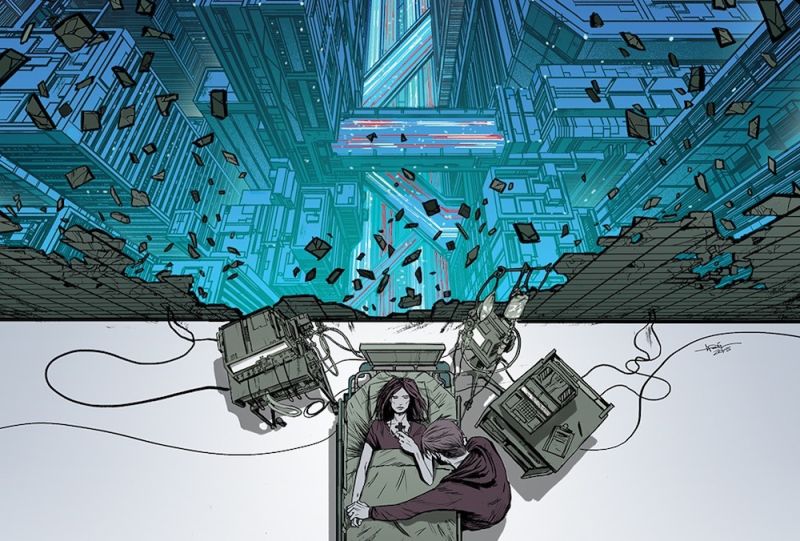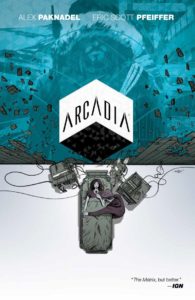
Written by Alex Paknadel
Illustrated by Eric Scott Pfeiffer
Lettered by Colin Bell
Review by Billy Seguire
 “We never left the world behind … it followed us in here” – Resolution Now Protestor
“We never left the world behind … it followed us in here” – Resolution Now Protestor
Modern science fiction has a fascination with virtual worlds. From Tron to The Matrix to Ready Player One, there’s an inherently satisfying sensation to imagining the world around you isn’t real and having access to godlike powers of creation. What the world would be like if we could bend it to our whims? What would we really do in a computer simulated world, where everybody knew it was a simulation? What would we become? In Arcadia, that last question in particular is explored in greater detail than any of the genre’s predecessors, with thoughtful storytelling and stylistic presence guiding an execution that accomplishes thought-provoking sci-fi that lasts. It drives itself deep into the side of your temple and uploads an amazing virtual experience.
The backstory of Arcadia is rooted in the kind of world-building that gives the story a solid foundation for success. Six years before the start of the book, a papilloma virus wipes out the majority of humanity. Those that cannot be saved, through the desperation of the surviving, are uploaded to Arcadia, a newly constructed haven where consciousness can live on after death and the greatest minds of the generation can continue working together for a cure. The most interesting concept Arcadia adds to the genre is the question of how the outside world maintains this virtual reality. The real world, the one that survived the pandemic, sees Arcadia as a drain on resources. A waste of energy spent on the dead while the living still scrape away at surviving. Arcadia, meanwhile, sees the real world as nothing more than “the meat”, there to service them and nothing more. As the years press on and societies grow separate from one another, what would the relationship be like? Woven into this story are hackers, natives, and a troublemaking lower class of pixel-persons who make up a fully realized, intricate world of Arcadia in a world that breathes with a life all its own.
Although the discussion of technology is brought up throughout, thematically it plays only a very small part. Instead of man vs. machines, it’s man vs. man: an eternal conflict that’s continued since the dawn of time carried over into the digital age. Both in the machine world and out, we see mankind’s vices and flaws on display as they struggle to take advantage of their precarious situations. Especially within the virtual world, class systems and inequality rear their head “when the powerful keep all the pixels to themselves” and a growing lower-class who cannot afford to pay for the energy resources necessary for keeping their own faces, instead becoming low resolution humanoids devoid of features. As the story progresses, the rifts between communities grows, with the have/have not dynamic also holding weight between the virtual and real worlds, with the top of the top truly ruling with the golden fist of the one percent. It’s a timely message that I think will resonate with the majority of readers, especially in its characterization of a skull-faced tyrant who oozes charm and shows remarkable finesse in his manipulation of the public.
From the first page, I was drawn in by Eric Scott Pfeiffer’s art. It uses the comic medium to the fullest advantage, laying out panels to keep the eye focussed on the right areas of the page and tell the story as dramatically as possible. The angular design of characters lends itself incredibly well to the virtual nature of the book and makes the derezzed lower class even more apparent as they shuffle about as grey formless husks. Colour has voice within this work. Used to create distinct visions for both the downtrodden real world outside of Arcadia and the unbound expressive spirit of the virtual domain, it’s one of the strongest elements Pfeiffer uses to assert the book’s tone. One of the best examples of smart colour use is in dialogue taking place within the inner mindscapes of characters. The blues and purples of the text bubbles in these sections are downright gorgeous and pop out against the muted backgrounds. It’s a beautiful combination of bright and dim that creates a memorable image to make Arcadia distinct.
With substories that enhance the world, Paknadel really works to add texture and substance to both worlds. Minor characters that only appear for as little as three pages hold weight over the shape of the story, and you get the feeling that there’s more around each corner of the story to give you as full a world as they realistically could. This isn’t a one trick pony made for utilitarian advantage. Arcadia is a universe rich in possibilities, and the creators made the right choice in not forcing themselves steadfastly down every path, leaving legions of ideas up the interpretation of the reader’s imagination and get minds moving around the book into unexplored corners of possibility.
Together, Alex Paknadel and Eric Scott Pfeiffer should be commended not only for creating a piece of great sci-fi, but also in ensuring that the work is an inclusive one that gives opportunities for all its characters to shine. Giving characters a range of skin tones and ethnicities throughout allows for a broader perspective in the cast, while also allowing for deeper visual interest on the page. It’s a seemingly no-brainer for a story that takes place across the virtual globe, but I have personally seen sci-fi defaulted to white male characters over and over again enough to appreciate other types of characters being explored when I can find it. The role of women in the story is another victory. While male characters are still at the forefront, there’s agency and voice to female characters in a way that defines their actions as their own, not merely for the story of their male peers. Lee Garner, our virtual protagonist, is a character who is could be blamed for multiple mistreatments towards women in the book, and is karmically punished by an imposing female force at the resolution of the book. Meanwhile Sam, Lee’s wife, ends up making a key decision at the end that’s driven as much by her own story as it is Arcadia’s, and owns her position with Lee as the centre of a complicated relationship.
The biggest praise I can give Arcadia is that it didn’t leave me alone after I had finished reading. If anything, it left questions burning in my head that provoked my own participation within the narrative of the story, pressing me to think deeply about the themes it was trying to explore. It doesn’t end on a note everyone will like, but it’s absolutely satisfying to what it’s built up and takes a brave direction, putting focus on characters you wouldn’t expect while staying true to its character’s motivations. It’s not clear cut, and leaves enough questions hanging about whether certain actions were just by the end to encourage discussion and theorization with fellow readers.
The Verdict:
Buy It! It has been too long since I seriously delved into a story that took me down as many roads as Arcadia delivers. While I was already a fan of the virtual worlds subgenre of science fiction, I found new avenues to appreciate through the telling of its dualistic story. It was the kind of book that made me want to go back and read it again, and my only regret is that its ending takes a few left turns that don’t let characters end up where I think they ought to have. Eric Scott Pfeiffer’s art fulfils the huge promises of this world in a way I’ve never seen before, keeping colour and boundless imagination alive in a virtual space you can believe is shaped by creative desire. Do not miss out on this engaging piece of work. Take the chance and buy Arcadia immediately.

![[REVIEW] CREEPSHOW #1](https://geekd-out.com/wp-content/uploads/2022/09/8064E22A-8E27-4753-BEAA-37C63CBCB1B4-150x150.webp)

